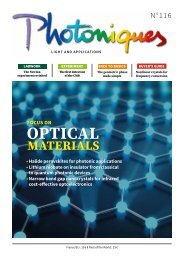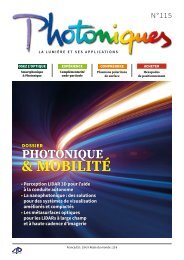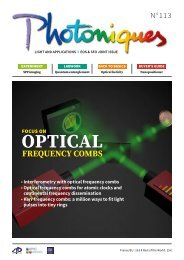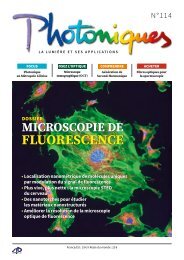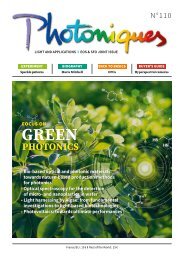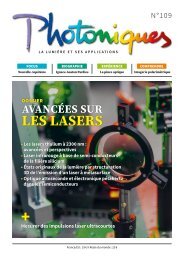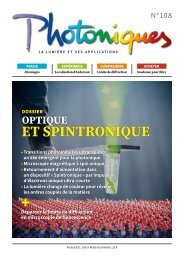EPN 53-3
Create successful ePaper yourself
Turn your PDF publications into a flip-book with our unique Google optimized e-Paper software.
LASERS FOR HEALTH<br />
FEATURES<br />
precise tissue ablation. Early examples of laser therapies were<br />
photocoagulation in the retina, destruction of skin lesions<br />
and removal of cardiovascular plaque. Nowadays, laser applications<br />
in medicine can be broadly classified in three categories:<br />
i) microscopy, for studying fundamental biological<br />
processes and understanding the cellular mechanisms leading<br />
to the development of diseases; ii) optical diagnosis, for<br />
real-time visualization of tissues and cells, also in the operating<br />
room and inside the body thanks to endoscopic probes;<br />
iii) laser surgery and light-activated therapies.<br />
Optical microscopy<br />
The birth of modern biology goes hand in hand with the invention<br />
of the optical microscope. In 1655 the English physicist<br />
Robert Hooke used one of the first compound optical<br />
microscopes to observe thin cork slices and coined the word<br />
“cells”, likening their structure to that of cubicles in monasteries.<br />
Since then, optical microscopy has gone a long way<br />
in imaging the composition of living cells and tissues and<br />
studying their dynamical evolution. With respect to other<br />
imaging techniques such as MRI, it has the advantage of high<br />
spatial resolution; with respect to electron microscopy, it has<br />
the advantage of being non-destructive, enabling to operate<br />
on living samples. While there are many imaging modalities,<br />
the most used, due to its sensitivity, is fluorescence, using<br />
either exogenous (such as dyes and quantum dots) or endogenous<br />
(such as fluorescent proteins) chromophores [6].<br />
The resolution of optical microscopy is set by diffraction<br />
of light and, according to Abbe’s limit, is of the order of half of<br />
the wavelength of light (or 200-300 nm in the visible range).<br />
Recently, super-resolution microscopy techniques such as<br />
stimulated emission depletion (STED) [7] and photoactivated<br />
localization microscopy (PALM) [8] enabled to overcome<br />
the diffraction limit by almost an order of magnitude<br />
and to understand biological function at the molecular level.<br />
Lasers for diagnostics<br />
Coherent vibrational microscopies, such as stimulated<br />
Raman scattering (SRS), enable to determine the chemical<br />
composition of cells and tissues in a label-free and non-destructive<br />
way [9]. The current gold standard of tumor diagnosis<br />
in histopathology is the century old H&E technique,<br />
which requires staining the tissue slices with the hematoxylin<br />
and eosin dyes, followed by visual inspection by the<br />
histopathologist. SRS promises to improve the diagnostic<br />
accuracy by measuring the vibrational response of unstained<br />
samples (virtual histopathology) [10] and providing not<br />
only morphological but also biochemical information (spectral<br />
histopathology).<br />
Many laser-based optical imaging techniques have been<br />
developed which are non-invasive and with high spatial resolution,<br />
employing a multiplicity of contrast mechanisms.<br />
They are used both in diagnosis and in therapy to enhance<br />
the precision of surgical interventions, enabling to distinguish<br />
between healthy and diseased tissue with<br />
<strong>EPN</strong> <strong>53</strong>/3 29



